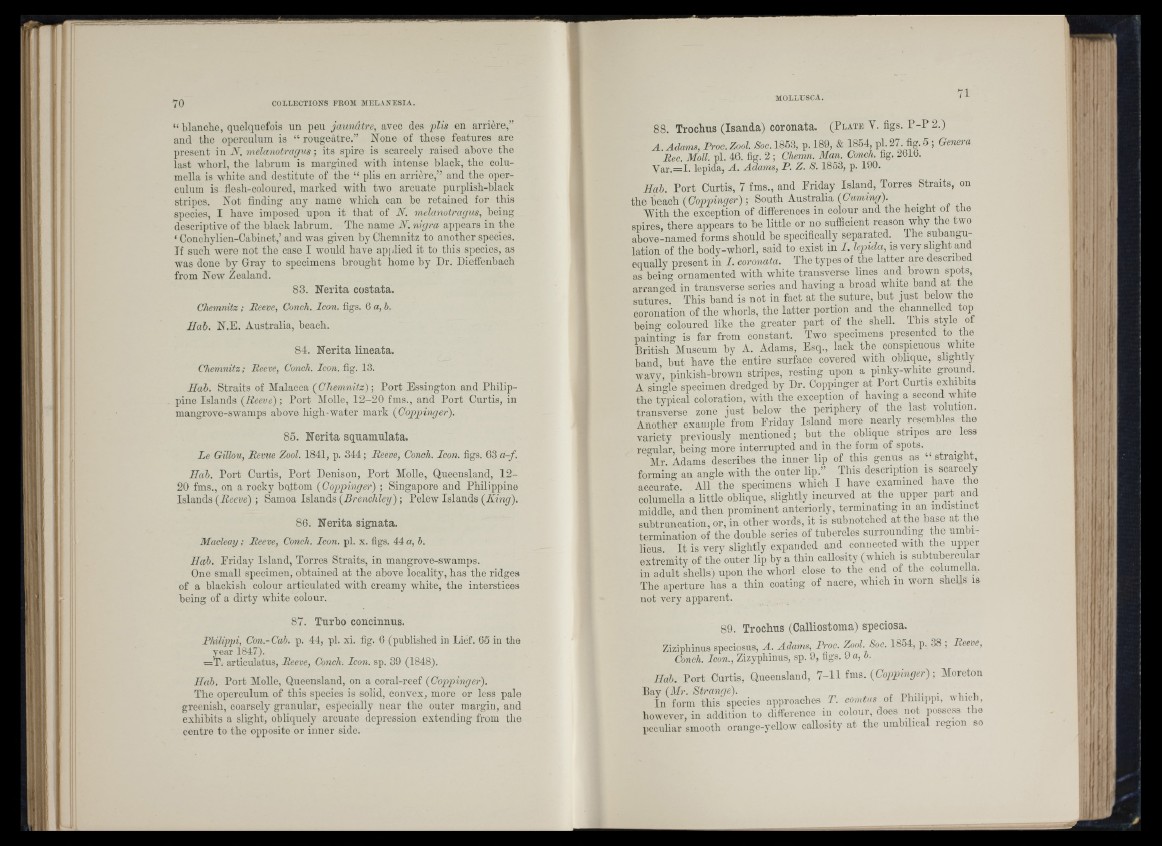
“ blanche, quelquefois un peu jaunâtre, avec des plis en arrière,”
and the operculum is “ rougeâtre.” None of these features are
present in N. melanotragus ; its spire is scarcely raised above the
last whorl, the labrum is margined Avith intense black, the columella
is Avhite and destitute of the “ plis en arrière,” and tho operculum
is flesh-coloured, marked with two arcuate purplish-black
stripes. Not finding any name Avhich can he retained for this
species, I have imposed upon it th at of N. melanotragus, being
descriptive of the black labrum. The name N. nigra appears in the
‘ Conchylien-Cabinet,’ and was given by Chemnitz to another species.
If such were not the case I would have apj.lied it to this species, as
was done by Gray to specimens brought homo by Dr. Dieffenhach
from Now Zealand.
83. Nerita costata.
Chemnitz ; Reeve, Conch. Icon. figs. 6 a, b.
Hab. N.E. Australia, beach.
81. Nerita lineata.
Chemnitz ; Reeve, Conch. Icon. fig. 13.
Ilah. Straits of Malacca {Chemnitz); Port Essington and Philippine
Islands {Reeve) ; Port Molle, 12-20 fms., and Port Curtis, in
mangrove-swamps above high-water mark {Coppinger).
85. Nerita sqnamulata.
Le Gillou, Revue Zool. 1841, p. 344; Reeve, Conch. Icon. figs. G3 a-f.
Ilah. Port Curtis, Port Denison, Port Molle, Queensland, 12-
20 fms., on a rocky bottom {Coppinger) ; Singapore and Philippine
Islands {Reeve) ; Samoa Islands {Brenchley) ; Pelew Islands {King).
86. Nerita signata.
Macleay ; Reeve, Conch. Icon. pi. x. figs. 44 a, b.
Hah. Friday Island, Torres Straits, in mangrove-swamps.
One small specimen, obtained at the above locality, has the ridges
of a blackish colour articulated with creamy white, the interstices
being of a dirty white colour.
87. Turbo concinnus.
RUlippi, Con.-Cab. p. 44, pi. xi. fig. 6 (published in Lief. 65 in the
year 1847).
='T. articulatus. Reeve, Conch. Icon. sp. 39 (1848).
Ilah, Port Molle, Queensland, on a coral-reef {Coppinger).
The operculum of this species is solid, convex, more or less pale
greenish, coarsely granular, especially near the outer margin, and
exhibits a slight, obliquely arcuate depression extending from the
centre to the opposite or inner side.
88. Trochus (Isanda) coronata. (P late V. figs. P -P 2.)
A. Adams, Rroc. Zool. Soc. 1853, p. 189, & 1854 pi. 27. fig. 5 ; Genera
Rec. Moll. pi. 46. fig. 2 ; Chemn. Mail. Conch, fig. 2616.
Var.=I. lepida, A. Adams, P. Z. S. 1853, p. 190.
Hah. Port Curtis, 7 fms., and Friday Island, Torres Straits, on
the beach {Coppinger) ; South Australia {Cuming).
With the exception of differences in colour and the height ol tlie
spires, there appears to he little or no sufficient reason why the two
above-named forms should be specifically separated. The snhaiigu-
lation of the body-whorl, said to exist in I . lepida, is very slight and
equally present in I. coronata. The types of the latter are described
as being ornamented with white transverse lines and brown spots,
arranged in transverse series and having a broad white hand at the
sutures. This band is not in fact at the suture, but ju st below the
coronation of tho whorls, the latter portion and the channelled top
being coloured like the greater part of the shell. I his style of
painting is far from constant. Two specimens presented to the
British Museum by A. Adams, Esq., lack the conspicuous white
band hut have the entire surface covered with oblique, slightly
wavy, pinkish-brown stripes, resting upon a pinky-whito ground.
A single specimen dredged by Dr. Coppinger at Port Curtis exhibits
tho typical coloration, with the exception of having a second white
transverse zone just below the periphery of the last volution.
Another example" from Friday Island more nearly resembles the
variety previously mentioned; but_ the oblique stripes are less
regular, being more interrupted and in the form of spots.
Mr. Adams describes the inner lip of this genus as “ straight,
forming an angle with the outer lip.” This description is scarcely
accurate. All the specimens which I have examined have the
columella a little oblique, slightly incurved at the iipper part and
middle, and then prominent anteriorly, terminating in an indistinct
suhtruncation, or, in other words, it is subnotched at the base at the
termination of tlie double series of tubercles surrounding the umbilicus.
I t is very slightly expanded and connected with the upper
extremity of the outer lip by a thin callosity (which is subtnberciilar
in adult shells') upon the whorl close to the end of the columella.
The aperture has a thin coating of nacre, which in worn shells is
not very apparent.
89. Trochus (Calliostoma) speciosa.
Ziziphinus speciosus, A. Adams, Proc. Zool. Soc. 18o4, p. 38 ; Reeve,
Conch. Icon., Zizypliinus, sp. 9, figs. 9 a, b.
Ilah. Port Curtis, Queensland, 1 - \ \ ims. {Coppinger); Moreton
approaches T. comtns of Philippi, which,
however, in addition to difference in colour, does not possess tho
peculiar smooth orangc-ycUow callosity at the umbilical region so
it
4 y.
I i